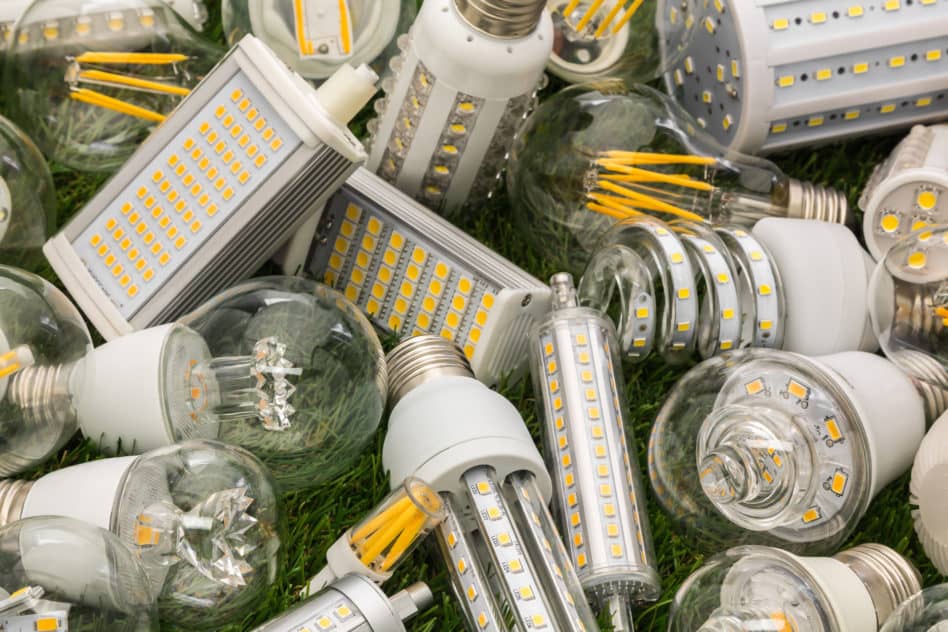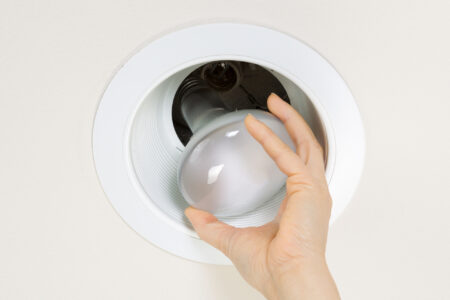Would you like to convert your lighting to modern LED technology? In many lamps the old illuminants can be easily replaced. In this article you will find out what you have to pay attention to during the LED conversion. In addition, I describe my own experiences when converting to LED.
Conversion to LED
The old light sources had their time. LED technology offers numerous advantages such as significantly lower energy consumption and a long lifespan. The conversion of the old lighting to LED lamps therefore is a reasonable step.
I used a move as an opportunity to change the complete lighting to LED. Of course it is up to you whether you want to change single lights or the whole household to LED in one step.
Good opportunities to convert to LED
- Defect of old illuminant
- New furnishing of a room
- Renovation
- Moving
Replace illuminant or get a new lamp?
There are two options for LED conversion. On the one hand the illuminants of the existing lamp can be replaced. Alternatively, the complete lamp can be replaced with a new lamp with integrated LED’s. Depending on the situation, one or the other solution may be more appropriate.
Replacing illuminants
The easiest way is to replace the old lamps with new ones using LED technology. Many lights in the house have bases of the type E26, E11 or GU10. There is a large selection of LED illuminants for these bases. A replacement of the illuminants is always useful if you want to keep the lamp itself for a few more years.
New LED lamp
If you are planning to buy a new lamp anyway, the purchase of a lamp with integrated LED’s can be useful. These are usually fix installed and cannot be replaced. Some find this disadvantageous, but this is unproblematic due to the long lifespan of LED’s. The advantages are completely new design possibilities.
When converting to LED I combined both versions. With many existing lights I converted the illuminants to LED. For new lamps to be purchased, I have immediately switched to those with integrated LED’s.
What to pay attention to when retrofitting?
Due to the variety of LED lamps, the conversion seems somewhat complicated at first glance. The LED technology is also more complex than the old light sources. Without being well-informed simply buying any LED light could result in later disappointment. But if you are interested in the following points before buying, you will be enthusiastic about the current LED technology.
Important considerations before retrofitting
- Which brightness is needed?
- What color temperature do I need?
- Which beam angle is suitable?
- Should the lamp be dimmable?
Which brightness is needed?
The brightness of LED lamps is no longer given in watts but in lumens. If you want to keep the brightness of the lamp after conversion, you have to find out the brightness of the old bulb. The Lumen Watt calculator will help you.
- In small corridors, rooms with a few square meters and on stairs I use LED lamps with 330 lm. This corresponds approximately to the brightness of a 35 W incandescent bulb.
- In the entrance area I use illuminants with 600 lm, which corresponds approximately to a conventional 50 W light.
- For a 16 sqm room I use a LED ceiling lamp with 1400 lm. This was however mostly too bright, why the light switch was replaced with a dimmer. This is usually adjusted to 50%.
Which beam angle is suitable?
Many old light sources had a strong light scattering and radiated the light all around. LED’s have a very directional radiation. For larger beam angles, several LED’s are usually installed in one illuminant. The required beam angle of a light source depends on the lamp to be converted.
- Especially with directional spots, the lumen value of the new LED lamps can usually be lower than with the old illuminant.
- The proportion of indirect light that is emitted to the rear or the ceiling, for example, can be omitted.
What color temperature do I need?
The color temperature describes the light color of an LED lamp. Depending on where it is used, there are different color temperatures from warm white to cold white. The exact value is given in Kelvin.
- I use lamps with a color temperature of 2700 K in the living area. This light color corresponds exactly to the warm white light of old incandescent lamps.
- For rooms like storage room and housekeeping room I use lamps with 3000 K. This light looks brighter, but less cozy.
Should the lamp be dimmable?
Unlike old incandescent lamps and halogen lamps, not all LED lamps can be dimmed. If you want to convert a dimmable lamp to LED, the new bulb or luminaire must be explicitly marked as dimmable.
Some dimmers of older lamps need a certain minimum load, which is not necessarily reached by the new LED lamps. In this case the new lamps flicker or hum or cannot be switched on at all.
- The conversion of dimmable lamps connected to an old dimmer can be one of the most difficult tasks. The only thing that helps here is to try it out.
- If the new LED lamp then functions perfectly and the brightness can be regulated, there is no need for further action.
- If the new lamp cannot be switched on or flickers or hums, the old dimmer must be replaced with a new LED dimmer.
What else is important?
Conversion of low-voltage lights
If low-voltage lights are to be converted to LED’s, a low-voltage variant must also be used. Low-voltage lights are not operated directly with 110V mains voltage. These are connected to a transformer, which usually generates a low-voltage of 12V.
When replacing LED light sources, the same difficulties can occur as when connecting to an old dimmer. Only trying out will help, whether the new LED lamps light up problem-free. Otherwise, the old transformer must be replaced with a new LED transformer.
Waste heat in small lamp glasses
Some luminaires have very small lamp glasses that tightly enclose the illuminant. Even if LED lamps have a high degree of efficiency, a certain part of the energy must be released into the environment in the form of heat.
If particularly bright and powerful lights are used in small lamp glasses, heat accumulation can occur. This can have a negative effect on the LED lifespan.
Retrofit all lights?
Due to my positive experiences with LED technology, I consider the LED conversion of all lights to be reasonable. However, under the following circumstances it must be carefully considered whether a conversion really makes sense or not.
- Lighting in very rarely used rooms such as sheds or storerooms (low lighting duration, therefore hardly any savings with LED)
- Lighting integrated in furniture (complicated conversion)
Which manufacturers to buy?
At the time of my conversion to LED, I found very little helpful information on the web. That’s why I first bought lamps from different manufacturers. Then I was able to get an idea of where the differences lie and what to look out for.
Most of the no-name lamps showed multiple disadvantages. There were switch-on delays, so that the illuminant produced light only a moment after the pressure on the light switch. Also annoying humming noises when switched on or a slight flickering could be observed.
Currently I mostly use LED luminaires and illuminants from Philips. These have none of the mentioned disadvantages and have also convinced me very much of the light quality. Also there was no defect after more than three years after the conversion, which speaks for the quality.
Conclusion
The purchase of new lamps has actually become a little more complicated with LED technology. But if you’ve read this article so far, you know what’s important when converting to LED. If you take these points and my experiences into account when making your purchase decision, nothing will keep you away from a successful LED conversion.






